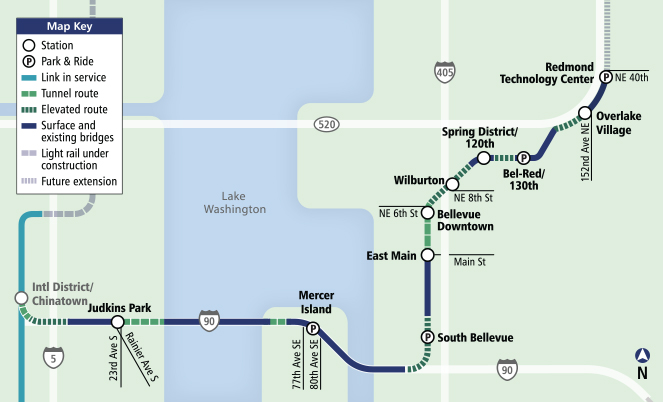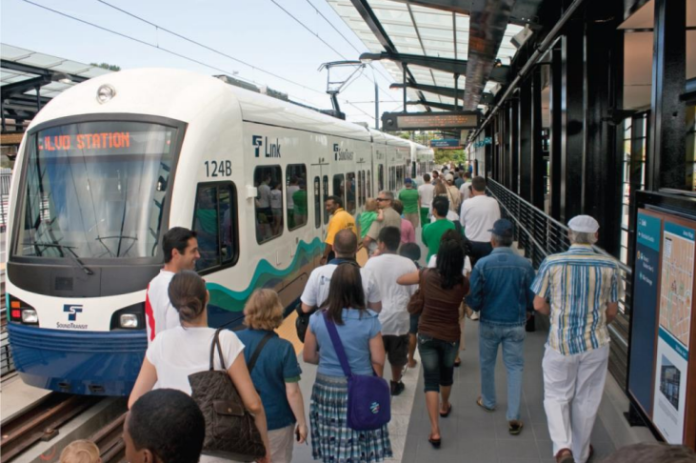Over the weekend The Seattle Times ran a story about the technology that will allow East Link to operate on a floating bridge and several other outlets picked up the story, including yours truly. Another outlet to pick up the story, CityLab, had a strange take for an urbanist publication:
Whether the project proves fruitful will depend on flawless execution—and on real ridership numbers matching the expected tens of thousands of passengers each day. It will also depend on whether it really cuts down on the volume of motor traffic, as it’s intended to.
Cutting motor traffic seemed like defining transit on highway engineer terms to me. Plus, Sound Transit was careful when promoting its successful ST3 package to advertise an alternative to sitting in traffic, rather than a cure for congestion. Meeting ridership projections is important, but “flawless execution” suggests setting a high bar just to see transit fail. Here’s how I’d define success for a transit upgrade:
- Does it save existing transit users time and improve the experience?
- Does it attract new riders?
- Does it empower better land use decisions and encourage walkability?
- Does it reduce car dependency?
- Does it create resiliency in the network?

Congestion is an inherent part of living in a booming metro. One can expect a successful light rail line to pull some people out of cars and into trains. Unfortunately, induced demand suggests road space created is likely to be filled by other motorists. The irony in defining success by highway traffic congestion relief is that to light rail users congestion is irrelevant. Light rail has its own right-of-way skirting right past congested urban highways. This is how grade-separated light rail creates resiliency in the transportation network: a major collision can temporarily take an interstate out of commission, but light rail in its own right-of-way will keep on moving. Congestion relief is how someone who does not actually ride light rail would likely define success, but the primary job of light rail is to serve transit users, not motorists.
East Link will provide transit users in downtown Bellevue a frequent ride to downtown Seattle all day long that reliably takes 25 minutes or less. That’s a massive upgrade in frequency, reliability, and speed. It’ll probably shave ten minutes off the 550 bus, plus be impervious to the all-too-frequent I-90 traffic jams. If we were providing that kind of time savings to motorists, they’d be throwing ticker-tape parades.
It seems a safe bet that East Link will meet ridership projections, which are pegged at 50,000 by 2030, as the whole region booms–with Bellevue and Redmond, where East Link serves, among the leaders in job and population growth. There’s ample reasons to expect healthy ridership. For one, Sound Transit made the projections before an unexpectedly large regional population boom. Secondly, regional transit use is trending up. Seattle’s transit ridership growth rate led the nation, and the light rail extension to Capitol Hill and Husky Stadium is already operating at 2018 projections. Finally, the land use changes and subsequent development along future transit spines are materializing at station areas, such as Bellevue’s Spring District boom long ahead of light rail operating.
It’s hard to justify East Link skepticism. A line connecting Seattle to downtown Bellevue and Redmond was one of the no-brainer routes in front of Sound Transit. Downtown Bellevue is sprouting 40-story high-rises while Redmond’s Microsoft campus is a major job center. It’s hard to see this line not paying off long-term. East Link will almost certainly succeed on urbanist terms by improving transit service and encouraging better land use decisions.
The featured image if from a joint Sound Transit and King County Metro open house presentation from 2014.
Doug Trumm is publisher of The Urbanist. An Urbanist writer since 2015, he dreams of pedestrian streets, bus lanes, and a mass-timber building spree to end our housing crisis. He graduated from the Evans School of Public Policy and Governance at the University of Washington in 2019. He lives in Seattle's Fremont neighborhood and loves to explore the city by foot and by bike.


